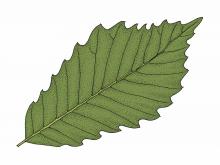Trees, Shrubs and Woody Vines
Media

Species Types
Scientific Name
Populus deltoides
Description
Named for the cottony fluffs of hairs attached to its tiny seeds, cottonwood thrives in moist lowlands near streams and rivers. It is Missouri’s fastest-growing native tree but pays for that distinction by being relatively short-lived.
Media

Species Types
Scientific Name
Ostrya virginiana
Description
Eastern hop hornbeam is named for its fruits, which are clusters of flattened, papery, scalelike sacs arranged in an overlapping pattern, like scales on a pinecone — resembling the hops that beer is made from.
Media

Species Types
Scientific Name
Salix spp. (about 12 species in Missouri)
Description
Exotic willows are available at lawn and garden centers, but there are several willow species that are native to Missouri. Most are rather humble colonizers of gravel bars, riverbanks, and lakesides. Many are important for human economic interests. All have a place in our wild ecosystems.
Media

Species Types
Scientific Name
Betula nigra
Description
River birch is a native tree easily identified by its reddish, papery, peeling bark. It is used extensively in landscaping, where many-stemmed groupings are planted in moist places in yards and along streams and ponds.
Media

Species Types
Scientific Name
Quercus prinoides
Description
The dwarf chestnut oak, though only 3–10 feet tall and the shortest of Missouri's oaks, can nevertheless produce abundant acorns that are relished by several types of birds and mammals.
Media

Species Types
Scientific Name
Quercus phellos
Description
Willow oak's leaves are narrow, pointed, and willowlike, and like willows, this oak is associated with wet ground. In Missouri, willow oak is only found natively in our southeastern counties.
Media

Species Types
Scientific Name
Quercus imbricaria
Description
Shingle oak got its name because the naturalist who discovered it noticed that French colonists in Illinois were using the wood to make roofing shingles. The leaves resemble those of laurel (bay), lacking lobes or teeth — but laurel trees don't bear acorns!
Media

Species Types
Scientific Name
Corylus americana
Description
American hazelnut is a thicket-forming shrub that grows to about 10 feet high. It is prized for its edible nuts, which are covered by a distinctive leafy or papery, jagged-edged bract.
Media

Species Types
Scientific Name
Fagus grandifolia
Description
Limited in our state to well-drained, sandy soils in southeast Missouri, American beech is an impressive tree that has provided Americans with wood for a variety of uses, from furniture to toys to fuel to beer barrels!
Media

Species Types
Scientific Name
Quercus muehlenbergii
Description
Chinkapin oak is fairly easy to identify because of its distinctively toothed leaves. Look for it growing in rocky soils derived from limestone or dolomite on bluffs and in upland woods, and in floodplain forests and lower slopes along streams.
See Also
About Trees, Shrubs and Woody Vines in Missouri
There are no sharp dividing lines between trees, shrubs, and woody vines, or even between woody and nonwoody plants. “Wood” is a type of tissue made of cellulose and lignin that many plants develop as they mature — whether they are “woody” or not. Trees are woody plants over 13 feet tall with a single trunk. Shrubs are less than 13 feet tall, with multiple stems. Vines require support or else sprawl over the ground.





















